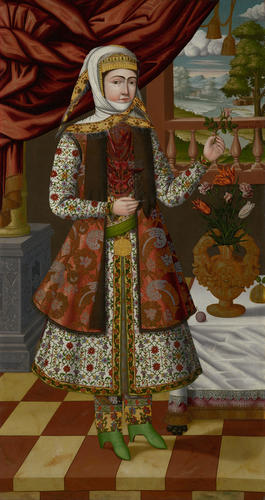-
1 of 253523 objects
Woman from New Julfa before 1650
Oil on canvas | 163.6 x 87.3 cm (support, canvas/panel/stretcher external) | RCIN 407299

Marcos (active 1640s)
Woman from New Julfa before 1650
-
One of three single-figure paintings (with RCINs 407811 and 407300) signed by Marcos, an otherwise unknown Armenian painter active in Isfahan, the cosmopolitan capital of Persia in the 17th century.
This female figure forms a pair with RCIN 407811. A handwritten inscription on the reverse of the canvas in Armenian reads ‘Girl from Julfa’, labelling her as an unmarried woman from Julfa (or ‘New Julfa’), the Armenian district of Isfahan. This area of the city was built in the early 17th century specifically to house the large, newly-arrived Armenian population and was named after the wealthy town of Julfa from which many of its residents had emigrated.
She wears a distinctive Armenian headdress that signifies her unmarried status consisting of a half gold band upon the forehead, adorned with precious stones, strings of pearls and hanging coins; with a scarf which wraps along the side of her face and under the chin. Two rows of gold medallions hang down to her waist: one of red beads with smaller medals, the other comprising a large medal depicting Christ Pantocrator with a Roman inscription around the edge. She wears a sleeveless, fur lined, silk brocade coat over a long white robe decorated with a multi-coloured floral trellis design trimmed with a band of stamped cotton and tied at the chest with red bows. Her diagonally striped trousers are trimmed at the hem with bands of stamped cotton and floral silk brocade tucked into green, high-heeled leather ankle boots.
In composition, the three paintings of this group derive from European full-length portraits. The figures pose facing the viewer on chequerboard tiled floors; to one side is a pillar partially covered by a heavy curtain; on the other, a window balustrade opens onto a pastoral vista; and beside each figures is a fabric-covered table bearing assorted European luxury wares. In one hand she pinches the stem of a rose while the other holds a twisted stem Venetian wine glass and on the table beside her are a plum and quince, fruits which typically accompanied wine in Safavid Persia. Also on the table is an Italian double handle grotesque vase filled with carnations and tulips, which appears to be taken directly from a Dutch still life. Such ‘foreign’ inclusions are the equivalent of Oriental rugs and Asian porcelain depicted in contemporary European portraits as signifiers of affluence through access to luxury commodities.
A large inscription on the balcony to the right of the figure names the painter and is written in both Latin (‘Marcos Fecit’) and Armenian. Just over twenty other single-figure paintings on canvas from Safavid Persia are known, but none are signed or attributed to a named artist. Marcos is believed to be one of many Armenian painters working in Isfahan in the 17th century. Another documented artist, Minas, is known to have trained with a Dutch painter in Aleppo before he established himself in Isfahan around 1630 and subsequently taught a generation of painters in a variety of media (‘in oil and without oil’ and on ‘paper, canvas, board, copper and on the wall’).
This type of Safavid single-figure painting closely corresponds to the wall paintings found in the merchants’ houses of New Julfa, the Armenian district of Isfahan. These murals are thought to depict the different indigenous groups who lived in Isfahan in their various styles of dress (Persian, Turkish, Armenian, Georgian, Indian and European). All three of the paintings in the Royal Collection similarly show different indigenous ‘types’ and depict vessels which allude to wine-drinking suggesting that they were intended to decorate entertaining spaces. The figures of the male-female pair (RCINs 407811 and 407299) as well as the objects that surround them and the elements of their dress all appear in other Safavid paintings by different hands, indicating the use of cartoons and pattern books by their artists.
In all three of Marcos’s paintings he focused heavily on the structure and layering of fabrics, perhaps unsurprising given the central role of New Julfan merchants in the international textile trade. Infrared analysis suggests the patterns for his fabrics existed on separate cartoons to those used for their shape and structure. The artist also applied small metal flakes (now tarnished) to the paint surface to mimic metal thread.
It is unknown how or when the three paintings arrived in England but their English Chinoiserie style frames are 17th century. The two female paintings are likely to be the ‘Two Indian women, at length’ which appear in James II’s inventory of Windsor Castle in 1688 and the male was apparently separated from them at that point. All three canvases have the same thin primary layer of varnish but a further layer was applied to the paintings of the two women. These later hung at Kensington Palace and Hampton Court Palace (described in inventories as either ‘Indian’ or “Chinese’) before returning to Windsor Castle where they were first recorded with the male pair to this painting (RCIN 407811) in 1872.
Provenance
First certainly recorded in the Page's Waiting Room at Hampton Court in 1835 (no 552)
-
Creator(s)
-
Medium and techniques
Oil on canvas
Measurements
163.6 x 87.3 cm (support, canvas/panel/stretcher external)
170.3 x 93.2 x 2.6 cm (frame, external)
Category
Object type(s)
Alternative title(s)
Portrait of an Asian Woman
Portrait (?) of a young woman
[Historic Title, 1835] Portrait of a Chinese Lady, previously entitled
[Historic Title, Walpole] Portrait of an Indian Lady